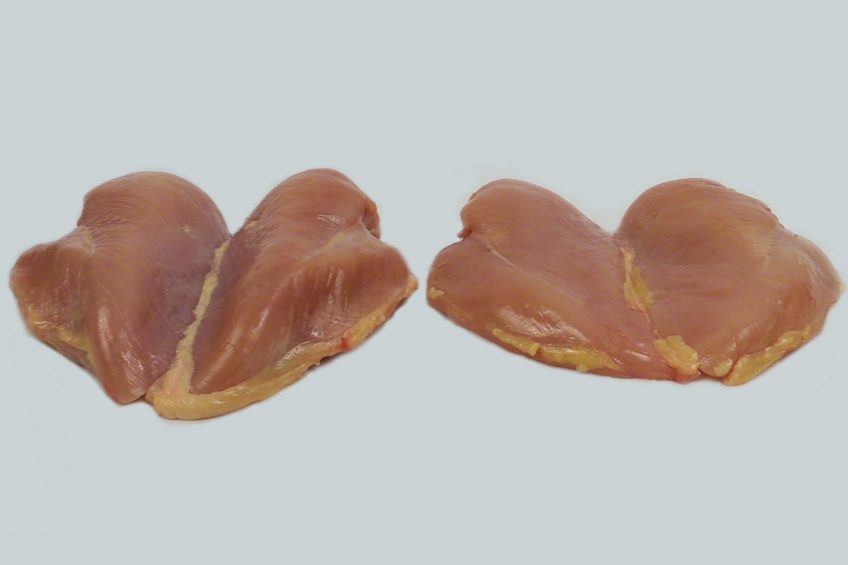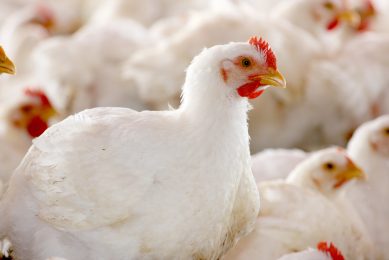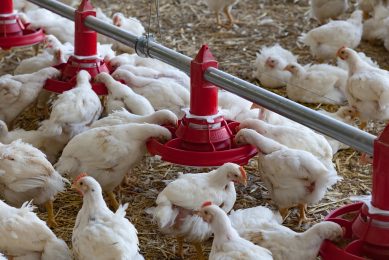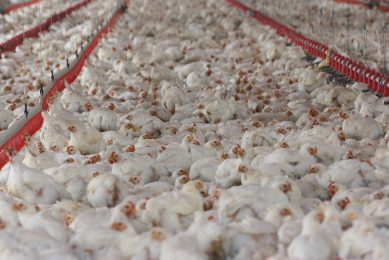Reduce woody breast and white striping with dietary approach

Recent findings indicate that altering broiler chicken diets can help mitigate the severity of woody breast and white striping, 2 poultry meat quality issues that appear to be increasing in prevalence in many markets.
A multitude of poultry researchers are exploring various approaches to eradicate these myopathies, and Novus International’s poultry scientists have recently concluded that organic trace minerals fed in combination with an antioxidant can significantly reduce the severity of these breast muscle myopathies in broiler chickens.
A combination of Mintrex trace minerals and Santoquin feed preservative can reduce the severity of woody breast and white striping by up to 50% based on the analysis of several studies in both commercial and research environments. As a result, Novus has identified a proven nutritional strategy to help mitigate severe incidences of these myopathies.
While these 2 meat quality issues do not pose any known risks to the food supply or consumers, they significantly impact producers. Severe cases can result in poultry meat of lower quality, leading to additional processing costs, downgrading of products and the potential condemnation of meat. It is estimated that the incidence of woody breast alone in poultry meat can be attributed to over $200 million of annual economic loss in the US. Finally, producers have actionable options to help protect against this loss. What leads to the incidence of the issue remains unclear, but producers can be reassured that the impact can be greatly reduced.
Reduce myopathies
A single solution to eradicate woody breast and white striping and preserve profits has been difficult to define because the exact cause remains unclear. It is known that some birds tend to show more frequent and severe cases, but the underlying cause has not been confirmed. However, the industry’s leading researchers have seen evidence that circulatory insufficiency and oxidative stress in the muscle are associated with the occurrence of these myopathies.
Woody breast, named for its hard or ‘wooden’ appearance, is the most severe and troublesome myopathy as it significantly impacts meat texture and taste, therefore impacting consumer acceptance. White striping is another type of myopathy where connective tissue creates white ‘stripes’ of varying thickness across the breast muscle, but this still affects meat quality. The industry has developed a rating system in which each abnormality is scored based on severity from 0 (no indication of myopathy) to 3 (severe).


Finding a solution
Often appearing together, these costly abnormalities are thought to arise from circulatory insufficiency and associated oxidative stress leading to loss of protein structural integrity. Knowing this, Novus’s research and development teams conducted several trials and unveiled the potential for preventing these deformities.
Dr Vivek Kuttappan, physiology research scientist at Novus said, “One of the most challenging aspects of creating a prevention strategy for broiler flocks experiencing high incidences of myopathy is finding and interpreting research. Because this area still requires a great deal of study, many new options and products advertised as potential solutions lack scientific support. Novus developed a recommended approach based on years of research, worked to prove hypotheses with our products and now has actionable plans for obtaining real results.”
2-pronged strategy
After analysing several studies, conducted in both research and commercial facilities, Novus’s 2-pronged nutritional strategy was developed:
- support healthy muscle growth and development
- reduce oxidative stress in the tissue.
To accomplish these objectives, highly bioavailable feed supplements were introduced to a well-balanced broiler diet with the intent to measure the reduction of the myopathies. Due to the natural processes surrounding muscle tissue growth and oxidative stress in broilers, trace minerals and antioxidants were selected due to their proven positive effects on bodyweight improvement and growth rates. Studies indicated that highly bioavailable trace minerals such as Mintrex could help reduce the amount of damage to broiler breast tissue from stress or other causes and help in the regeneration process if damage occurs. It was then hypothesised that the same trace minerals that support healthy muscle growth could help reduce the development of abnormal tissue.
It was subsequently confirmed that broilers fed Mintrex trace minerals had significant reductions in meat quality issues such as woody breast and white striping when compared against those fed inorganic trace minerals. 4 trials comparing inorganic trace minerals of various components against Novus’s organic trace minerals recorded reduced incidence of woody breast with Mintrex with an average decrease of 44% (Figure 1). 2 of those trials also analysed white striping, recording a reduction in severe white striping by 46.1% (Figure 2).
Complete utilisation of the minerals available
The organic trace minerals include the chemically-different HMTBa molecule (methionine precursor) as a ligand bound to the mineral itself. The strong bond allows the mineral to reach the proper absorption site in the small intestine, providing better utilisation of the mineral by the animal. This means birds are better equipped with the nutritional tools for optimal muscle growth and development. In this case, the stimulation of healthy processes allows broiler chickens to better handle obstacles to tissue growth and helps prevent the development of myopathies.
In addition, antioxidants have a known role in reducing stress in muscle tissues. Santoquin feed preservative was added to broiler diets to determine if it also influenced meat quality. The studies showed the increased support to growing healthy muscle tissue that Mintrex offers was compounded when used in combination with Santoquin.
“Santoquin, as an effective antioxidant, works in tandem with Mintrex to reduce oxidative stress in muscles,” Kuttappan said. “Together, Novus’s products work to stimulate healthy growth and repair processes, helping to mitigate the negative effects of costly myopathies.”
Economic Impact
Woody breast and white striping are particularly costly to the broiler market as they affect one of the most valuable cuts from the carcass: breast fillets. Kuttappan’s estimate of $200 million USD in loss in the US could increase due to a USDA Food Safety and Inspection Service directive that gives instructions for proper trimming and condemnation of severe woody breasts that exhibit inflammatory tissues such as “thick gelatinous yellow fluid and/or hemorrhagic tissues.” These areas are to be removed and classified as “unfit for human consumption,” according to the directive.
Dr Ajay Bhoyar, Snr Manager of Global Technical Marketing for Novus, explained why this could impact costs. “Possible increases in labour costs to inspect or additionally process affected fillets could increase the economic losses felt by US poultry producers even further. These costs can be attributed to a processed product with a lower profit margin, catalysing the losses seen in affected birds,” he said.
Globally, the impact varies from region to region as size, market age and other environmental factors play a role in the occurrence of the myopathies, as well as the different requirements and preferences of consumers in that area.
What this means for the producer
Trace minerals and antioxidants are already known as essential tools for healthy growth and performance in broilers, but Novus’s finding that their products can help reduce costly myopathy appearances is a unique benefit with a clear return on investment. Economic losses resulting from the additional inspections, processing, possible downgrades or condemnation of product could be salvaged by producers, making significant differences to those marketing birds in markets with higher incidence rates. A proper nutritional strategy consists of several elements that can contribute to significantly reducing woody breast and white striping.
“Choosing high quality trace minerals with high bioavailability is crucial in achieving the combined effect with the antioxidant to see the reduction,” said Bhoyar. Based on science, Novus’s suggested broiler diet strategy can serve as part of a comprehensive solution to help reduce the incidence of these myopathies.
Join 31,000+ subscribers
Subscribe to our newsletter to stay updated about all the need-to-know content in the poultry sector, three times a week. Beheer
Beheer




![Improved performance and stronger egg shells are some of the traits enhanced by chelated trace minerals. [Photo: World Poultry]](https://www.poultryworld.net/app/uploads/2021/04/001_419_rb-image-2724060-389x260.jpeg)
 WP Admin
WP Admin  Bewerk bericht
Bewerk bericht